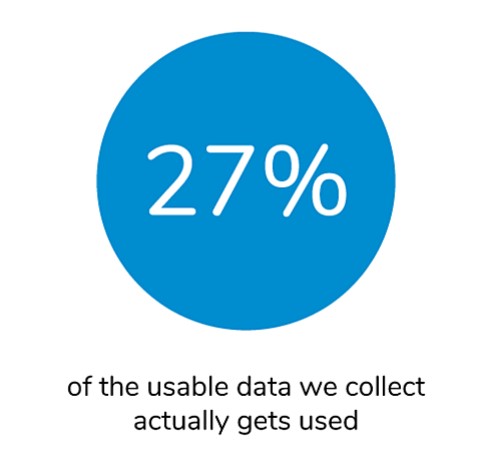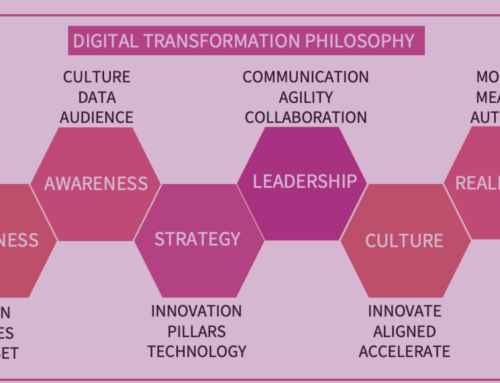Over the past 2 years, I’ve seen multiple organisations evolve out of the emerging digital wave and into the accelerating digital wave. I’ve worked with many of them to help them navigate their way, ride the wave successfully and go on to grow and thrive.
It doesn’t matter if you work in government or in the financial services, information technology, oil and gas, government or pharmaceutical industries. I’ve worked with them all, and I’ve identified what distinguishes those who succeed from those who don’t.
When I go in to help organisations get on track, those businesses that have previously struggled with digital transformation always keep coming back to the questions of ‘why’ transformations have failed, and left them them vulnerable to disruption.
It’s because the strategy to measure data has not been defined and no-one is taking responsibility of what new data should be measured.
And one of the first conversations I usually find myself having with them begins with this:
“Take a data driven strategy out of the digital transformation process and all you are doing is designing a better version of the past.”
The one common denominator of the companies that go through successful digital transformation is that they’ve followed a data driven strategy.
According to a recent report by Accenture, data-driven organizations with an enterprise strategy are actually growing at an average of more than 30% annually, and 90% of corporate strategies are expected to recognise the importance of data by 2022.

Just recently, I had a great example of how a strategic approach works, and the benefits it can bring.
For six months, I worked with a core team of digital champions in Saudi Arabia, and during our time together, we achieved many successes from reducing touchpoints on a user journey, implementing 100% paperless loans and (my personal favourite) saving 40,000 hours of manual work with RPA.
In partnership with Automation Anywhere, a global leader in robotic process automation (RPA), Arab National Bank automated 35 manual repetitive business, and more than 100 software bots now perform tasks within the bank’s operations, compliance, HR and other departments.
Reported in Arab News, ANB’s COO Aiedh Al-Zahrani, “Automation Anywhere technology is enabling the future of banking, by allowing financial institutions like ours to achieve significant cost savings, whilst providing higher levels of productivity and efficiencies. We successfully migrated more than 100 bots onto the Automation 360 platform, with almost zero downtime, thus saving an estimated 40,000 hours of manual work.”
Read the full article here.
ANB achieved these results through having a clear data driven strategy.
What is a data-driven business strategy?
Taking a data-driven approach means that your strategic decisions are based on data; examining, organising and analysing data with the objective of improving products or services for your customers. Making changes based on the stories your data tell, you can make more accurate decisions, become more cost-effective, improve sales and gain more competitive advantage.
By using data to understand your business processes, you can cut costs or come up with new innovations. You can understand where to invest and what to cut loose. From finance to marketing, customer service to research and development, using data to drive every aspect of your business can have huge benefits, and is a necessity in today’s digital world.
Before you can achieve that, though, you have to ask yourself some crucial questions.
According to DemandJump, only 27% of useable data collected is ever used.

So avoid wasting time and resources on data that you don’t need, your first step is to understand what kind of decisions you need to make, and how much data is enough to base these decisions on.
In a marketing role, you might, for example, ask yourself questions like:
- Where should we be investing our marketing budget and resources?
- What messages will resonate and engage with our customers?
- What should we be doing to increase conversions?
- What types of content should we be creating?
Of, if you are an HR leader, your questions might be based around a business problem that needs to be resolved in terms of skill sets, or how potential candidates are responding to your recruitment marketing.
Once you know the questions you need to answer, you can then ask yourself:
- What kind of data do we need?
- Where is this data collected from and stored?
- How much time do we need to collect it over, and how frequently?
- How will we make sense of the data we collect?
So why should you be developing and implementing a data-driven strategy, and what are the main benefits?
The precise benefits will depend on your business, and there could be many more of them, but I can share with you a few of the main ones.
- Make more accurate decisions
If you’re a successful business leader, you probably have enough experience that you get a strong gut feeling about what the right direction to take could be. That’s all well and good. But while intuition is a great attribute, it can only take you so far, and is always filtered through your own personal perspective.
By applying a data-driven strategy, you can remove the bias of your personal filters, and make decisions based on real facts. Your data will tell you, truthfully, what’s working and what’s not, whether one option is delivering better than another and the impact of particular decisions.
Basing your decision-making processes on listening to what your data tells you can guarantee that you make the right decisions that will take you towards a more innovate, growth business.
- Drive action through real insight
Gathering and using data gives you the possibility of examining your business from every angle, with total objectivity. The insights you gain from minute scrutiny of every aspect of your organisation, will enable you to refine your customer experience to meet and exceed your customers’ wants, needs and expectations.
These insights will also tell you whether a particular product isn’t selling, or whether there are issues with aspects of your service – telling you whether you need to adapt it, improve it, start doing something new or stop doing something altogether.
Data will reveal opportunities, and a data-driven strategy will allow you to become more proactive.
- See and understand your customers
In this digital age, we’re able to collect customer data like never before. Using it will allow you to get to know so much about your customers, their gender, age, location, interests, occupation, buying behaviours, and so much more. With the ability to collate and unify data from different sources, you’ll be able to build up a clear picture of your customers, and better understand their preferences, the digital platforms they prefer to inhabit, and how, when and where to engage with them.
Getting to know your customers better is essential to understanding, and exceeding, their expectations. It’s how you keep them coming back, and how you can turn top customers into top fans, and even brand advocates.
- Reduce costs and improve efficiency
A data-driven strategy can do more than merely inform and aid your understanding. It can identify opportunities to reduce expenses in terms of time spent on certain tasks – often business processes that can be automated, freeing up resource for more innovative roles, or allowing you to shift budget allocation towards activities which your data have revealed to be important.
- Improve transparency and accountability
Being able to see the numbers can improve transparency and accountability across any organisation. This allows you to measure and boost the effectiveness of teams, and to monitor and build better engagement with your employees – all performance enhancing benefits. Using data to drive management decisions also allows your employees at all levels to be more in control of their team and individual objectives. Data enables you to set more meaningful goals, and to measure the results of everyone’s efforts. Again, using properly managed data removes bias, and the numbers tell a coherent and indisputable story.
Perhaps the biggest reason why you should implement a data-driven business strategy is that data doesn’t lie. Whether you are a CEO, CFO, CMO, HR Director, or are in any other leadership role, you should be using data to drive your key business decisions, and for that to work, you need a data-driven strategy.
A final word on successful digital transformation.
Although the success of digital transformation has data at its heart, and you’ll need the right technology in place to leverage its benefits, never forget that a business is also all about people. In this Think Digital First blog, I explore ways to align company culture with digital transformation.
Ready to produce game-changing digital results in your business?
Subscribe to receive cutting edge insights on digital leadership and transformation- straight to your inbox
We do not sell or share your information with anyone.










Data-Driven Strategies need to become more “Standard” when it comes to really managing a company. Also for consulting businesses the focus needs to shift.